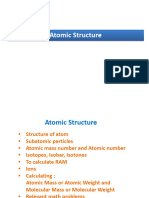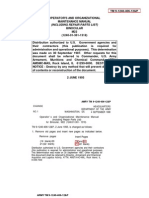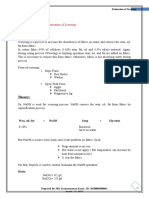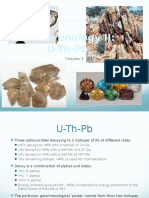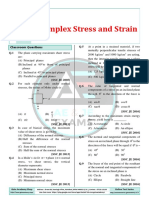CSEC Physics - The Atom
CSEC Physics - The Atom
Uploaded by
Cornflakes ToastedCopyright:
Available Formats
CSEC Physics - The Atom
CSEC Physics - The Atom
Uploaded by
Cornflakes ToastedOriginal Description:
Copyright
Available Formats
Share this document
Did you find this document useful?
Is this content inappropriate?
Copyright:
Available Formats
CSEC Physics - The Atom
CSEC Physics - The Atom
Uploaded by
Cornflakes ToastedCopyright:
Available Formats
The Atom
Thursday, 19 January 2023 8:57 AM
The atom is defined as an indivisible component which remains
after a substance is broken into its smallest prats
Theories of Atomic Structure
Thomas Dalton: Billiard Ball Model
Atom are whole particles and cannot be broken up further
Joseph Thomson: Plum Pudding Model
Atoms consist of tiny concentrated negative charges floating in
a positive cloud.
Ernest Rutherford: Planetary Model
Used the Geiger-Marsden experiment to explain his theory:
Nuclear Physics Page 1
Positive particles are used to bombard gold foil. It is expected from
Thomson's model that the positive particles will pass straight
through the foil and most do, however some are deflected at large
angles and some back toward the source, So Rutherford
concludes that the atom must have a small, dense, positive
nucleus with negative charges orbiting. The orbits are elliptical
and only one electron per orbit
James Chadwick: The Neutron
Chadwick bombarded a block of paraffin wax with rays produced
by Beryllium and found that protons were knocked out. The rays
produced by the Beryllium element had no charge (unaffected by
magnetic or electric fields)
Now recall from the p.c.m., when 2 objects A and B collide, if the
mass of A = mass of B then for A travelling at speed 'v' and B
initially stationary, then after the collision B moves off with
speed 'v' and A is stationary.
Since the rays of no charge did not pass through the paraffin
but rather knocked out protons at the same speed as the rays,
Chadwick concluded that there must exist a particle within the
nucleus of no charge he called the neutron
Niels Bohr: The Shell Model
Nuclear Physics Page 2
• Circular orbits of electrons
• Each orbit has an associated electron level
• Can contain pairs of electrons
• Are called shells
Structure of the Atom
• Made up of 3 particles
○ Protons
○ Neutrons
○ Electrons
• Charges
○ Robert Millikan determined that
▪ Charge of an e- is approximately -1.6 * 10-19C
○ The simplest atom, H, has 1e-, 1p+ and 1n
▪ Atom is neutral
▪ Charge of proton is therefore 1.6 * 10-19C
○ This is known as the elementary charge
○ The charge Q on any object is given as Q ± ne
▪ N is a whole number
Particle Charge
e- -e
p+ +e
n 0
• Masses
○ Charge to mass ratio (e/m) from Thomson's experiment:
▪ 2 * 1011 CKg-1
▪ Accepted value today is 1.76 * 1011 CKg-1
○ Accepted mass values of 3 subatomic particles are given
Nuclear Physics Page 3
○ Accepted mass values of 3 subatomic particles are given
in kg or in unified atomic mass units (u)
▪ 1 u = 1.6605 * 10-27kg
Particle Mass/kg Mass/u Mass/u (to
nearest whole
number)
electron 9.1094*1031 0.00054858 0
proton 1.67262*10-27 1.007276 1
neutron 1.67493*10-27 1.008665 1
Stability of the Atom
• 2 types of particles within nucleus
○ Protons & neutrons
• Called nucleons
• Size is exaggerated in diagrams to show them
Stability of Nucleus
• In hydrogen atom, nucleus consists of 1 proton
○ Electron orbits
• Next simplest atom is He
• Has 2 protons
○ Have alike charges and would repel
○ Neutrons prevent from flying apart
○ Hold the protons together
• Force keeping particles together called strong nuclear force
• Acts only within the nucleus
• Nucleus of different elements made up of different amounts
of protons and neutrons
• Proton number, Z, is called atomic number
• Number of neutrons, N, can be the same in different
elements
• An equal number of protons and neutrons results in stable
nuclei
• Mass number or nucleon number, A = Z+N
Nuclear Physics Page 4
Stable Energy States Among the Orbiting Electrons
• Electrostatic forces are the second most powerful forces in
nature, second to nuclear forces
• Positive and negative charges attract each other
○ Results in net zero charge on most objects
• Atoms in their normal state are electrically neutral
○ Has equal electrons and protons
Isotopes
• Elements with the same atomic number but different mass
numbers
○ i.e. different numbers of neutrons
• Some elements are indistinguishable from their isotopes
• Some elements have several isotopes
• Nuclides of some are radioactive
• Nuclei of carbon-14 give off beta particles
• Carbon-12 atoms are stable
Nuclear Physics Page 5
You might also like
- Thorium - Energy For The Future PDFDocument533 pagesThorium - Energy For The Future PDFCeline Azizieh100% (1)
- CGF All Jerels Posts OrmusDocument42 pagesCGF All Jerels Posts OrmusCiro GiordanoNo ratings yet
- Jamaica Driver's Education Handbook: A Comprehensive Driver Training GuideFrom EverandJamaica Driver's Education Handbook: A Comprehensive Driver Training GuideNo ratings yet
- Subatomic ParticlesDocument11 pagesSubatomic ParticlesStelle KimNo ratings yet
- Ch-2Document14 pagesCh-2aafatima167No ratings yet
- The Structure of The AtomDocument12 pagesThe Structure of The AtombrentlouisericamoraNo ratings yet
- Wala ToDocument168 pagesWala ToBlaize Aurellius B. CordeneteNo ratings yet
- Atomic Structure: Vinay Desai M.SC Radiation Physics Kidwai Memorial Institute of OncologyDocument28 pagesAtomic Structure: Vinay Desai M.SC Radiation Physics Kidwai Memorial Institute of OncologyJerry De Leon LptNo ratings yet
- 01-Atomic N Nuclear StructureDocument23 pages01-Atomic N Nuclear StructureEngr Umair AzizNo ratings yet
- Particle Physics 221216 121646Document44 pagesParticle Physics 221216 121646Nur Ainna LiyanaNo ratings yet
- Atomic Structure-Fundamental Pertcles To Photoelectric EffectDocument63 pagesAtomic Structure-Fundamental Pertcles To Photoelectric EffectRandome GamedevNo ratings yet
- Pert - 13 - Konversi Energi NuklirDocument29 pagesPert - 13 - Konversi Energi Nuklirvickyananda6567No ratings yet
- Structure of Atoms and NucleiDocument44 pagesStructure of Atoms and NucleiSONIA OSTWALNo ratings yet
- 9-Lecture 9Document29 pages9-Lecture 9george.1023077No ratings yet
- First Year Chemistry 20-02Document100 pagesFirst Year Chemistry 20-02Ahmed Hassan Mina HamadNo ratings yet
- Nuclear Physics - Intoduction To The Atom and Nuclear ReactionsDocument12 pagesNuclear Physics - Intoduction To The Atom and Nuclear ReactionsJohn ProtoctisNo ratings yet
- Atomic Structure PDFDocument59 pagesAtomic Structure PDFNashraat BukhoryNo ratings yet
- The Atom For AnatomyDocument106 pagesThe Atom For AnatomyAlexandra B. FloresNo ratings yet
- Chapter 4. Structure of The AtomDocument11 pagesChapter 4. Structure of The Atomnirmal krisnaNo ratings yet
- Lecture 2. Atomic Structure and Interatomic BondingDocument69 pagesLecture 2. Atomic Structure and Interatomic BondinggiftstephensmwaleNo ratings yet
- Chapter 2.1 - Structure of AtomDocument46 pagesChapter 2.1 - Structure of AtomHakim Abbas Ali PhalasiyaNo ratings yet
- 8TH Atomic StructureDocument65 pages8TH Atomic StructureAnna Maria DominicNo ratings yet
- PHS 214 2024Document20 pagesPHS 214 2024favourabiola123No ratings yet
- Atomic Nucleus and RadioactivityDocument59 pagesAtomic Nucleus and Radioactivitymladen lakic100% (2)
- Atomic Models PDFDocument6 pagesAtomic Models PDFkaranlodhi0552No ratings yet
- Nuclei Chapter 12 Class12 PhysicsDocument30 pagesNuclei Chapter 12 Class12 Physicsharikeshsingh45497No ratings yet
- Semiconductor BasicsDocument94 pagesSemiconductor BasicsArindam SenNo ratings yet
- Atomic StructureDocument33 pagesAtomic Structureshikshyapokhrel3003No ratings yet
- Nuclear PhysicsDocument24 pagesNuclear PhysicsCalvin LabialNo ratings yet
- Atomic Stru Best NotesDocument36 pagesAtomic Stru Best Notesiampriyatiwarii890No ratings yet
- NuclearDocument117 pagesNuclearsarfaraz khanNo ratings yet
- Basic Radiation ConceptsDocument44 pagesBasic Radiation Conceptsjoytenedero30No ratings yet
- Introduction To Nuclear EngineeringDocument58 pagesIntroduction To Nuclear EngineeringTanzim Rafat AyonNo ratings yet
- TRM 12Document96 pagesTRM 12KayKhaing OoNo ratings yet
- Structure of Atom (Race)Document38 pagesStructure of Atom (Race)arpitbhadauriya073No ratings yet
- ANFT1101Document60 pagesANFT1101ggdd4328No ratings yet
- Basic Electrostatics (2019)Document21 pagesBasic Electrostatics (2019)Andile MinenhleNo ratings yet
- 1. Atomic Structure (Physical Chemistry)Document13 pages1. Atomic Structure (Physical Chemistry)Lin Latt Wai AlexaNo ratings yet
- PM1 and Prepharm 2022 Lecture SlidesDocument225 pagesPM1 and Prepharm 2022 Lecture SlidesMary KallonNo ratings yet
- Concept+1+Notes+ +Structure+of+the+AtomDocument9 pagesConcept+1+Notes+ +Structure+of+the+AtomsanchezsolsalmaNo ratings yet
- Chapter 1 DEO40023 Dis 2020Document25 pagesChapter 1 DEO40023 Dis 2020muhamad reduan bin abu bakarNo ratings yet
- 13 Nuclei-FDocument45 pages13 Nuclei-FolxboysNo ratings yet
- 1.1 - Atomic - Structure - NiveenDocument41 pages1.1 - Atomic - Structure - NiveenMariamNo ratings yet
- Chapter 2.1 - Structure of Atom 2Document60 pagesChapter 2.1 - Structure of Atom 2Hakim Abbas Ali PhalasiyaNo ratings yet
- Atomic Structure: Name: Mr. Burnett Date: 03/05/2021 Class: 6A PhysicsDocument50 pagesAtomic Structure: Name: Mr. Burnett Date: 03/05/2021 Class: 6A PhysicsACSVNo ratings yet
- Nuclear Chemistry: P. Nagaraja Assistant Professor in Chemistry Ap Iiit, RK Valley, RguktDocument27 pagesNuclear Chemistry: P. Nagaraja Assistant Professor in Chemistry Ap Iiit, RK Valley, RguktGORIPARTHI PENCHALA PRASADNo ratings yet
- New Grade 8 - Atomic StructureDocument24 pagesNew Grade 8 - Atomic StructureSwetu GoudNo ratings yet
- Chapter 2Document41 pagesChapter 2t4q7fvsrc2No ratings yet
- The AtomDocument49 pagesThe Atomj.louielotino4No ratings yet
- The Structure of AtomsDocument159 pagesThe Structure of Atomsallendale123No ratings yet
- 2020 - 2021 Atom and Subatomic ParticlesDocument37 pages2020 - 2021 Atom and Subatomic ParticlesGeraldine LatupeirissaNo ratings yet
- 9 - Chemistry Unit 3 (ATOMIC STRUCTURE)Document16 pages9 - Chemistry Unit 3 (ATOMIC STRUCTURE)khawararainNo ratings yet
- ML11229A664Document147 pagesML11229A664briankipchumba830No ratings yet
- Unless Otherwise Stated, All Images in This File Have Been Reproduced FromDocument19 pagesUnless Otherwise Stated, All Images in This File Have Been Reproduced FromLucille MelbourneNo ratings yet
- 1.1 The Nature of Atoms Jan 2019Document37 pages1.1 The Nature of Atoms Jan 2019Dima SabeehNo ratings yet
- Opto Lecture 3&4Document59 pagesOpto Lecture 3&4RoverNo ratings yet
- The Nature of Molecules: BIO 103-L2Document29 pagesThe Nature of Molecules: BIO 103-L2Nahid Sagar 1812889042No ratings yet
- RevisionDocument13 pagesRevisionrajayush67780No ratings yet
- Atomic Structure 1Document15 pagesAtomic Structure 1animenba07No ratings yet
- Atomic StructureDocument35 pagesAtomic StructureShahadat Hossain ShafinNo ratings yet
- Concepts of Nuclear Medicine Volume I: Concepts of Nuclear Medicine, #1From EverandConcepts of Nuclear Medicine Volume I: Concepts of Nuclear Medicine, #1No ratings yet
- CSEC Chemistry - Structure and BondingDocument10 pagesCSEC Chemistry - Structure and BondingCornflakes ToastedNo ratings yet
- CSEC Chemistry - ElectrochemistryDocument7 pagesCSEC Chemistry - ElectrochemistryCornflakes Toasted100% (1)
- CSEC Chemistry - Acids, Bases and SaltsDocument4 pagesCSEC Chemistry - Acids, Bases and SaltsCornflakes ToastedNo ratings yet
- CSEC Chemistry - EnergeticsDocument5 pagesCSEC Chemistry - EnergeticsCornflakes ToastedNo ratings yet
- CSEC Physics - MagnetismDocument5 pagesCSEC Physics - MagnetismCornflakes ToastedNo ratings yet
- Electromagnetism CSEC NotesDocument10 pagesElectromagnetism CSEC NotesCornflakes Toasted100% (1)
- ROOTS OF A QUADRATIC Add Math PDFDocument1 pageROOTS OF A QUADRATIC Add Math PDFCornflakes ToastedNo ratings yet
- Csec Quadratic Add Math QuestionsDocument2 pagesCsec Quadratic Add Math QuestionsCornflakes ToastedNo ratings yet
- CellsDocument116 pagesCellsCornflakes ToastedNo ratings yet
- Half DeflectionDocument3 pagesHalf DeflectionShyrestha BarNo ratings yet
- Bda 30603 PDFDocument7 pagesBda 30603 PDFDaniel LauNo ratings yet
- Transfer ChuteDocument127 pagesTransfer ChuteVenkat Reddy Yedulla50% (6)
- Linear Algebra EB/BE 104: by Dr. Shaimaa Y. AbdelkaderDocument23 pagesLinear Algebra EB/BE 104: by Dr. Shaimaa Y. AbdelkaderAhmed M. RezkNo ratings yet
- Dynamic Analysis of Lathe Machine Tool: KeywordsDocument3 pagesDynamic Analysis of Lathe Machine Tool: KeywordsKevin Sanchez LoayzaNo ratings yet
- B6766 M22 Bino Mod CNDocument33 pagesB6766 M22 Bino Mod CNComanche5100% (1)
- Zlib - Pub Basic ElectronicsDocument629 pagesZlib - Pub Basic ElectronicsJean Goujon100% (1)
- ChemosDocument5 pagesChemosstava6000No ratings yet
- An 217 - How To Measure Thin Insulation Sample With The HFMDocument5 pagesAn 217 - How To Measure Thin Insulation Sample With The HFMDJASSOU Adjoavi ColetteNo ratings yet
- Flow Measurements TutorialDocument18 pagesFlow Measurements TutorialHabiba AmrNo ratings yet
- Analysis of Failure Effect of Cage Thickness On Spherical Roller BearingsDocument7 pagesAnalysis of Failure Effect of Cage Thickness On Spherical Roller BearingsKamolwan WeerachatsakulNo ratings yet
- Quantum Anharmonic Oscillator, A Computational ApproachDocument3 pagesQuantum Anharmonic Oscillator, A Computational ApproachInternational Journal of computational Engineering research (IJCER)No ratings yet
- Mars Curiosity LaunchDocument63 pagesMars Curiosity LaunchAviation/Space History LibraryNo ratings yet
- Rebars (318-05)Document8 pagesRebars (318-05)Sana UllahNo ratings yet
- Mec442 KJM492Document6 pagesMec442 KJM492afnanhananyNo ratings yet
- Screw Conveyor Applications VFD Settings: S.No Parameters Specification Set ValueDocument1 pageScrew Conveyor Applications VFD Settings: S.No Parameters Specification Set ValuePraveen ChoudharyNo ratings yet
- Integral Cos 5 (2x) : Assuming "Integral" Is An Integral Use As InsteadDocument3 pagesIntegral Cos 5 (2x) : Assuming "Integral" Is An Integral Use As InsteadFranky Gonzalez HernandezNo ratings yet
- Aggregate Base CourseDocument14 pagesAggregate Base CourseAy Bolz0% (1)
- Earthing Calculation PDFDocument65 pagesEarthing Calculation PDFcdsenthilNo ratings yet
- 1556 RFA Manual TehnicDocument36 pages1556 RFA Manual Tehnicd403242No ratings yet
- Experiment No: 01 Experiment Name: Estimation of ScouringDocument7 pagesExperiment No: 01 Experiment Name: Estimation of ScouringMd. Sazzadul Islam100% (2)
- 04 CENG8432 Governing Equations For Anisotropic and OrthotropicDocument49 pages04 CENG8432 Governing Equations For Anisotropic and OrthotropicHENOKNo ratings yet
- F322 June 2010 Mark SchemeDocument23 pagesF322 June 2010 Mark SchemetanbirukNo ratings yet
- Soil Stabilisation Rice Husk Ash N GGBSDocument374 pagesSoil Stabilisation Rice Husk Ash N GGBSElaMazlanNo ratings yet
- Spatial Light ValveDocument2 pagesSpatial Light ValveMicralyneNo ratings yet
- Chapter 3Document48 pagesChapter 3Karena GillNo ratings yet
- 0260268cb9586-Chapter 2 Complex Stress and StrainDocument7 pages0260268cb9586-Chapter 2 Complex Stress and StrainAman JaiswalNo ratings yet
- Part Three: Modifications To Mix Design Method: Reference Stage Item or Calculation Values 1Document2 pagesPart Three: Modifications To Mix Design Method: Reference Stage Item or Calculation Values 1Asraf Muidin100% (2)




























































